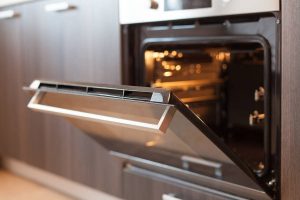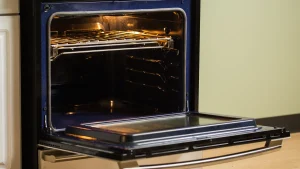Updated on March 12, 2023
For busy weeknight dinners or elaborate dinner parties, there is no time for oven problems. You need to be prepared for every eventuality. What to look out for and how to fix common oven problems are laid out in this guide. Make sure to call in a professional if you’re having trouble getting your oven back up and running.
What Is Wrong with My Electric Oven
The oven may be getting power, but it may not be able to switch on for a variety of reasons. A broken wire, a defective control, bake, or broil element, or the wrong amount of power entering the unit are all common issues with electric ovens. Control, ignition, or valve malfunctions are all common causes of gas oven failure.
Oven Light Doesn’t Work
Initially, you may want to replace the bulb. It could be a malfunctioning light switch, electrical control, or connecting wire if that doesn’t work Let an appliance repair specialist tackle these oven difficulties because of the high risk of electrocution.

Oven Door Won’t Open or Shut
Try disconnecting the appliance or turning off the circuit breaker for five minutes if it doesn’t open after a self-cleaning cycle. Try opening the door again after regaining power by gently moving the door lock lever. Otherwise, try resetting the self-cleaning cycle, giving it 15 minutes to work, and then cancelling the cycle. To open the oven door again, move the door lock lever and wait a few minutes.
There could be a problem with the oven door hinge. Disassembling the door and potentially removing the side panel may be necessary for this procedure to work. If you’re in a bind, you can always rely on an appliance repair professional.
Oven Won’t Self-Clean
An oven’s self-cleaning feature may not work due to a number of typical problems. In order to start the self-cleaning cycle, verify that the oven door switch is secured properly.
You may have an issue with a temperature control thermostat, wires, or an oven controller board or thermal fuse if that’s not the case. Don’t try to fix these parts on your own; call a professional appliance repair service.
Oven Won’t Turn On
The refrigerator, oven, and dishwasher should all be on separate circuits to avoid tripping breakers. To begin with, make sure the appliance is connected in and that no circuit breakers have been tripped in the junction box.
The oven may be getting power, but it may not be able to switch on for a variety of reasons. A broken wire, a defective control, bake, or broil element, or the wrong amount of power entering the unit are all common issues with electric ovens. Control, ignition, or valve malfunctions are all common causes of gas oven failure. You should not attempt to troubleshoot these difficulties on your own due to the potential for electric shock.
The Oven Won’t Heat
For a gas oven, a malfunctioning igniter or heating element is the most common cause of an oven that won’t heat (for an electric oven). It’s most possible that the issue is with your gas line if your gas oven and burners have both ceased operating. The heating element or igniter may, however, be replaced by you.

- Remove the old heating element or igniter with a screwdriver. In most ovens, the heating elements are found on the inside, while the igniter is usually found on the bottom.
- Remove the broiler or storage drawer to gain access to your igniter.
- Before performing any maintenance on your oven, make sure the power has been turned off.
- It’s possible that you’ll need to hire a professional to replace a hidden heating element.
Why Is Your Electric Cooktop Not Heating Up?
When an electric stove starts up, but takes a long time to heat up, there are a few possible causes. Unplugging the device is the first step in troubleshooting and fixing the problem. Electric shock is definitely not something you want to add to the list of issues. Allow it to cool down if you’ve recently used the cooktop. Even if it’s the power receptacle or the switch, it’s most likely the burner.
1. Check the Power Source Receptacle
The accumulation of grease, oil, and moisture in the power outlet might lead to a malfunction. It could eventually lead to arcing. Electrical shorts can damage heating elements even if they are only intermittent and appear to be safe. Cleaning the element tips inside the container on a regular basis will help to keep this from happening.
Changing the heating element necessitates changing the power source receptacle as well. If the receptacle is damaged, you may not see it. Perhaps it was the cause of the heating element failure in the first place.
2. Loose or Burnt Wire
Be sure to inspect all of the electrical lines while you’re checking the power receptacle and other components. Look for indicators of damage, such as burn marks, and loose connections.
As long as you are certain there is no damage, loose wires can be replaced safely. It’s important to check the connections of any burned wires to ensure that the other components – like the element and switch – are unaffected.
3. Burned Out Heating Element
Electricity is directed to a heating element using a selector switch. The element heats up as the circuit closes once the knob is turned to a specific temperature setting. A burnt-out element could be the cause of a malfunctioning electric stove.
One thing you may do before opting to replace the heating element is to clean it first and inspect it better. Cleaning on a regular basis is, incidentally, strongly advised.
Blistering, cracks, and bubbling should be obvious on typical stove burners. The coils under the ceramic top of a radiant burner should be examined for burn spots and other indicators of damage.
To fix a problem with a plug-in element, you merely have to elevate it slightly and then pull it out. Check the prongs for damage and clean them if necessary if this is your burner. Replace the element and run a heat test to ensure it’s heating properly this time.
Indirectly wired heating elements can be a little trickier. To see if the cooktop can be raised, look in the owner’s manual. To open some, you have to press the upper half back first before you can lift it. In some cases, the front edges may have to be lifted first. It’s a good sign if yours features a back hinge that makes it simple to open.
Breaks aren’t always clear to the naked eye. Changing out the heating coil may be necessary if something seems amiss. When troubling indications are absent, it does not mean there is no problem. Using a multimeter to check for continuity is the only way to be sure. If you’re not sure what’s causing the elements to not heat up, you may want to look into other probable explanations.
The procedure for replacing the heating element on a conventional burner is straightforward after you’ve established that it needs to be replaced. For ceramic-top cooktops, however, the process is a little more involved.
Take out the clamps that hold in the electrical wires that are coming out of the ceramic insulator. Unscrew the screws holding the wires in place. If you don’t know which wire goes where, label it. In order to rebuild the device, put in the new element and connect all of its wires.
4. Faulty Selector Switch
There is a specific switch for turning on and off each heating element. This switch also regulates the amount of voltage, which is why the heat is generated. After achieving the specified temperature, it automatically switches off the power. Throughout the entire cooking process, it is a never-ending loop.
Changing the element can be a time-consuming way to test the switch. Depending on the size, you can either buy a brand new one or rent a working one for a short period of time. If, in fact, the switch is faulty, then replacing it should resolve the issue of your electric stove not heating properly.
5. Replace the Plug-in Burner
Electric cooktops manufactured by GE and Kenmore often feature plug-in burners. Carefully replace it if necessary.
To remove the plug-in burner, you would typically merely raise and pull the outer coil. There isn’t a lot of work involved in setting one up. A simple push of the prongs forward locks it in place and prevents it from falling out of the socket.

